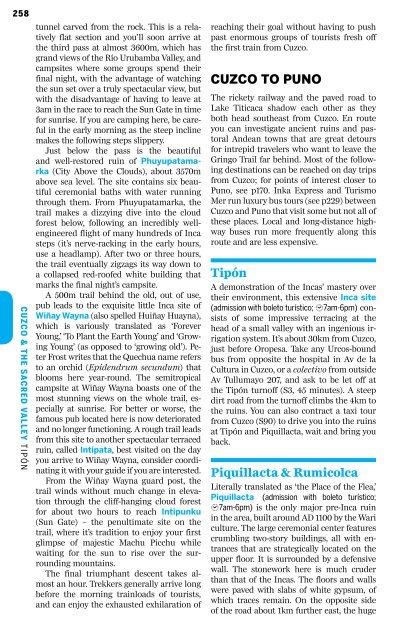peru-8-cuzco-sacred-valley
You also want an ePaper? Increase the reach of your titles
YUMPU automatically turns print PDFs into web optimized ePapers that Google loves.
258<br />
Cuzco & the Sacred Valley C T I H u P E zC Ó H N O I K TO E P U N O<br />
tunnel carved from the rock. This is a relatively<br />
flat section and you’ll soon arrive at<br />
the third pass at almost 3600m, which has<br />
grand views of the Río Urubamba Valley, and<br />
campsites where some groups spend their<br />
final night, with the advantage of watching<br />
the sun set over a truly spectacular view, but<br />
with the disadvantage of having to leave at<br />
3am in the race to reach the Sun Gate in time<br />
for sunrise. If you are camping here, be careful<br />
in the early morning as the steep incline<br />
makes the following steps slippery.<br />
Just below the pass is the beautiful<br />
and well-restored ruin of Phuyupatamarka<br />
(City Above the Clouds), about 3570m<br />
above sea level. The site contains six beautiful<br />
ceremonial baths with water running<br />
through them. From Phuyupatamarka, the<br />
trail makes a dizzying dive into the cloud<br />
forest below, following an incredibly wellengineered<br />
flight of many hundreds of Inca<br />
steps (it’s nerve-racking in the early hours,<br />
use a headlamp). After two or three hours,<br />
the trail eventually zigzags its way down to<br />
a collapsed red-roofed white building that<br />
marks the final night’s campsite.<br />
A 500m trail behind the old, out of use,<br />
pub leads to the exquisite little Inca site of<br />
Wiñay Wayna (also spelled Huiñay Huayna),<br />
which is variously translated as ‘Forever<br />
Young,’ ‘To Plant the Earth Young’ and ‘Growing<br />
Young’ (as opposed to ‘growing old’). Peter<br />
Frost writes that the Quechua name refers<br />
to an orchid (Epidendrum secundum) that<br />
blooms here year-round. The semitropical<br />
campsite at Wiñay Wayna boasts one of the<br />
most stunning views on the whole trail, especially<br />
at sunrise. For better or worse, the<br />
famous pub located here is now deteriorated<br />
and no longer functioning. A rough trail leads<br />
from this site to another spectacular terraced<br />
ruin, called Intipata, best visited on the day<br />
you arrive to Wiñay Wayna, consider coordinating<br />
it with your guide if you are interested.<br />
From the Wiñay Wayna guard post, the<br />
trail winds without much change in elevation<br />
through the cliff-hanging cloud forest<br />
for about two hours to reach Intipunku<br />
(Sun Gate) – the penultimate site on the<br />
trail, where it’s tradition to enjoy your first<br />
glimpse of majestic Machu Picchu while<br />
waiting for the sun to rise over the surrounding<br />
mountains.<br />
The final triumphant descent takes almost<br />
an hour. Trekkers generally arrive long<br />
before the morning trainloads of tourists,<br />
and can enjoy the exhausted exhilaration of<br />
reaching their goal without having to push<br />
past enormous groups of tourists fresh off<br />
the first train from Cuzco.<br />
CUZCO TO PUNO<br />
The rickety railway and the paved road to<br />
Lake Titicaca shadow each other as they<br />
both head southeast from Cuzco. En route<br />
you can investigate ancient ruins and pastoral<br />
Andean towns that are great detours<br />
for intrepid travelers who want to leave the<br />
Gringo Trail far behind. Most of the following<br />
destinations can be reached on day trips<br />
from Cuzco; for points of interest closer to<br />
Puno, see p170. Inka Express and Turismo<br />
Mer run luxury bus tours (see p229) between<br />
Cuzco and Puno that visit some but not all of<br />
these places. Local and long-distance highway<br />
buses run more frequently along this<br />
route and are less expensive.<br />
Tipón<br />
A demonstration of the Incas’ mastery over<br />
their environment, this extensive Inca site<br />
(admission with boleto turístico; h7am-6pm) consists<br />
of some impressive terracing at the<br />
head of a small <strong>valley</strong> with an ingenious irrigation<br />
system. It’s about 30km from Cuzco,<br />
just before Oropesa. Take any Urcos-bound<br />
bus from opposite the hospital in Av de la<br />
Cultura in Cuzco, or a colectivo from outside<br />
Av Tullumayo 207, and ask to be let off at<br />
the Tipón turnoff (S3, 45 minutes). A steep<br />
dirt road from the turnoff climbs the 4km to<br />
the ruins. You can also contract a taxi tour<br />
from Cuzco (S90) to drive you into the ruins<br />
at Tipón and Piquillacta, wait and bring you<br />
back.<br />
Piquillacta & Rumicolca<br />
Literally translated as ‘the Place of the Flea,’<br />
Piquillacta (admission with boleto turístico;<br />
h7am-6pm) is the only major pre-Inca ruin<br />
in the area, built around AD 1100 by the Wari<br />
culture. The large ceremonial center features<br />
crumbling two-story buildings, all with entrances<br />
that are strategically located on the<br />
upper floor. It is surrounded by a defensive<br />
wall. The stonework here is much cruder<br />
than that of the Incas. The floors and walls<br />
were paved with slabs of white gypsum, of<br />
which traces remain. On the opposite side<br />
of the road about 1km further east, the huge


